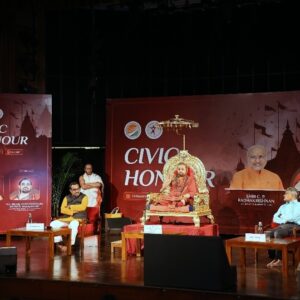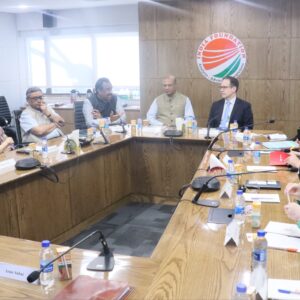~ By Jayraj Pandya
“The dream of India as a great nation, which we had seen during the Freedom Struggle, continues to inspire us even today. To some extent, this dream has been realized. Yet, a lot more remains to be accomplished.”1
- Bharat Ratna Shri Atal Bihari Vajpayee in his last independence day address on 15th August 2003
In the backdrop of these words and after a passage of ten years, the Bharatiya Janata Party (BJP) led National Democratic Alliance (NDA) won a resounding mandate in the General Elections 2014. The BJP achieved a landslide victory by securing 2822 seats out of the total 543 seats and in the process, became the first party to win a complete majority in the Lok Sabha after a span of 30 years. The new dispensation at the Centre faced colossal challenges such as an economy in doldrums, restive demographic dividend, foreign policy in tatters and much more. It required a Herculean effort on the part of Prime Minister Narendra Modi led NDA government to bring India out of its troubles, most of which being self-inflicted due to policy paralysis and lack of effective governance. This has put the country back on the trajectory of high growth and prosperity. The effort of this paper is to constructively analyse the progress achieved during the first two years of the NDA Government.
Changing Perceptions, Bursting Myths
Rather than going through the mundane SWOT (Strengths, Weaknesses, Opportunities and Threats) approach in analysing the performance of the Prime Minister Modi-led government, the approach used here is to perform an appraisal on the metrics of ability to positively change perceptions and bursting conventional and age-old myths.
The biggest positive development which has been witnessed under the new regime has been the significant rise in diplomatic capital of the country. Even there, most of this capital has been equity capital and not debt capital i.e. efforts have been made to foster long-term relations with foreign nations and in making them partners in our growth story. Right from the start of this Government’s term by extending invitations to heads of SAARC nations, to operationalising the landmark India-Bangladesh Land-Boundary agreement (LBA) and from rekindling the Indian diaspora with the nation to display of the statesmanlike approach by the Prime Minister in dealing with global leaders and multilateral institutions for best interests of the nation, the country has witnessed an unprecedented global spotlight during the past 24 months of this regime.
On the economic front, the country was battling a baffling quadrangular conundrum comprising of severe policy paralysis, high inflation, the Twin Balance Sheet (TBS) challenge and low and jobless economic growth. Blatant corrupt practices at a mammoth scale, a hallmark of the previous dispensation, led to self-induced policy paralysis stalling big-ticket investment projects in key sectors such as energy, infrastructure and transportation. Under the Pragati (Pro-Active Governance and Timely Implementation) initiative whereby the Prime Minister directly reviews stalled projects- 108 of the 350 Centre-state projects, worth over Rs 3 lakh crore across critical infrastructure sectors like railways, national highways, power and civil aviation, interminably delayed for the past four to 15 years, have been revived.3 The ardent push to electrify each and every village in the country, doubling the speed of creation of highways in the country and several other such silent revolutions marked the resurgence of infrastructure creation in the country.
Despite two consecutive years of drought, the earnest and consistent efforts made by the Government including creating Price Stabilisation Fund (PSF) for preventing volatility in agricultural commodities, restricting imports of pulses, enabling strict action against black marketers4 and timely imposition of stock-holding limits of essential commodities8 has ensured that the days of double-digit Consumer Price Inflation (CPI) are behind us.
Perhaps the biggest perception changer can be seen in the Rational Investor Ratings Index (RIRI), a tool created in Economic Survey 2014-15 to gauge the investor confidence. As can be seen, India performs well not only in terms of the change of the index but also in terms of the level, which compares favourably to its peers in the BBB investment grade and even its “betters” in the A grade. (India is in the BBB investment category according to Fitch rating agency. A is the category just above it.) 5
Expanding the limits for Foreign Direct Investment (FDI) in key areas including insurance and defence sectors, improving ease of doing business in the country, passing key legislations for financial reforms such as the Insolvency and Bankruptcy Law, initiation of Indradhanush program for revival of Public Sector Banks (PSBs)6 and a host of other such progressive measures led to India becoming the fastest growing large economy in the world during the year 2015-167 and also the top destination for FDI across the world in 20168.
The biggest myth prevailing in the country- the economically and socially backward classes can only be uplifted through doles and freebies has been debunked with various affirmative actions taken by this Government leading to empowerment of citizens across the board. The cause of social advancement has been championed by the NDA Government through its flagship programs including providing a bank account in each household (Jan-Dhan , more than 22 crore bank accounts opened9), providing life and accident insurance to citizens (Jan Suraksha, 12 crore beneficiaries reached10), crop insurance program (Pradhan Mantri Fasal Bima Yojana), providing incentives for economic upliftment through skill training (Skill India), disbursement of loans to small and micro entrepreneurs (MUDRA, over Rs. 1 lac crore disbursed to over 2.7 crore account holders11) and through creating a conducive culture for start-ups in the country (Start-up India, Stand-up India).
The arduous push to the Direct Benefit Transfer (DBT) program through development of Jan-Dhan, Aadhaar, and Mobile (JAM) Trinity has been a major development in institutionalising a change in framework for provision of subsidies and services to the citizens. The first variety of JAM- PAHAL scheme of transferring LPG subsidies via DBT has been a tremendous success under this regime. As the Economic Survey stated- Based on prices and subsidy levels in 2014- 15, the potential annual fiscal savings of Pahal will be Rs. 12,700 crore in a subsequent Financial Year.12
Merely looking at the performance of this Government from the prism of tangible achievements would be a misnomer. The tough stance of the Prime Minister over the conduct of his Council as well as the bureaucracy has ensured that corruption, which became a hallmark of the previous dispensation, is done away with, in his tenure. This dispensation has championed several initiatives with an aim to bring about a change in the very mindsets of the citizens such as Swachh Bharat Mission, improving accessibility for Divyang citizens (Accessible India), digital storage of important documents of citizens (DigiLocker), creating an open platform for connecting with citizens (mygov.in), real-time outreach on social media for grievance redressal and more. This Government has also tried to break conventional mindsets ingrained in the bureaucratic system in the country through far-reaching measures such as real-time tracking of attendance of government officers (attendance.gov.in), direct access to citizens to seek appointments (myvisit.gov.in), allowing self-attestation of documents to prevent harassment of citizens and repealing of over 1100 archaic laws in the country13.
The Way Ahead
In the last two years, the NDA Government has been taking giant strides on the path of equitable social, economic and cultural progress but still a lot more remains to be achieved. Just like Bharat Ratna Shri Vajpayee, Prime Minister Modi, in his speech on the completion of 2 years of the Government reiterated his commitment towards the nation by saying-
“Work done by our Government in last 2 years is now an inspiration for us to serve the country even better.”14
The author is a Research Fellow at India Foundation. The views expressed are his own.
(This article appeared in India Foundation Journal, May-June 2016 issue.)
References
1. Prime Minister Shri Atal Bihari Vajpayee’s Independence Day Address, Former Prime Ministers of India- Prime Minister’s Office, 15th August 2003, New Delhi
Can be accessed at- http://archivepmo.nic.in/abv/speech-details.php?nodeid=9239; last accessed at: 20th June 2016
2. Performance of National parties in General Elections 2014, Election Commission of India, New Delhi, 2014
Can be accessed at- http://eci.nic.in/eci_main/archiveofge2014/20%20-%20Performance%20of%20National%20Parties.pdf; last accessed at: 20th June 2016
3. Off the blocks: PM Narendra Modi’s big push to get stalled Centre-state projects off the ground, India Today, June 9, 2016
Can be accessed at: http://indiatoday.intoday.in/story/narendra-modi-project-pragati/1/687740.html; last accessed at: 20th June 2016
- Inflation: LOK SABHA UNSTARRED QUESTION NO. 2448 TO BE ANSWERED ON MARCH 11, 2016; Lok Sabha: Parliament of India, 11th March 2016
Can be accessed at- http://164.100.47.190/loksabhaquestions/annex/7/AU2448.pdf; last accessed at: 20th June 2016
- Economic Outlook, Prospects, and Policy Challenges, Economic Survey of India- Pg. 9, February 2016
Can be accessed at- http://indiabudget.nic.in/es2015-16/echapvol1-01.pdf; last accessed at: 20th June 2016
- Indradhanush: Plan for Revamp of Public Sector Banks; Ministry of Finance, August 14, 2015
Can be accessed at: http://financialservices.gov.in/PressnoteIndardhanush.pdf; last accessed at: 20th June 2016
- GDP: At 7.6%, India’s growth points to fastest growing large economy, Indian Express, 1st June 2016
Can be accessed at: http://indianexpress.com/article/business/economy/gdp-7-9-percent-its-official-india-is-now-the-fastest-growing-economy-in-the-world/; last accessed at: 20th June 2016
- The fDi Report 2016: Global Greenfield investment trends, Financial Times, 2016
Can be accessed at: http://forms.fdiintelligence.com/report2016/files/The_fDi_Report_2016.pdf; last accessed at: 20th June 2016
- Progress Report: Pradhan Mantri Jan Dhan Yojana, Ministry of Finance, As on 15th June 2016
Can be accessed at: http://www.pmjdy.gov.in/account; last accessed at: 20th June 2016
- Daily Enrolment for Pradhan Mantri Jan Suraksha Yojana, Ministry of Finance, As on 18th June 2016
Can be accessed at: http://www.jansuraksha.gov.in/claims-reported.aspx; last accessed at: 20th June 2016
- MUDRA Loans: LOK SABHA UNSTARRED QUESTION No. 1584 TO BE ANSWERED ON THE 4th March, 2016, Lok Sabha: Parliament of India, 4th March 2016
Can be accessed at: http://164.100.47.190/loksabhaquestions/annex/7/AU1584.pdf; last accessed at: 20th June 2016
- Spreading JAM across India’s economy; Economic Survey of India- Pg. 57, February 2016
Can be accessed at: http://indiabudget.nic.in/es2015-16/echapvol1-03.pdf; last accessed at: 20th June 2016
- Mohan Vishwa, 1159 obsolete laws scrapped by Modi govt; 1,301 junked in previous 64 years, Times of India, 19th May 2016
Can be accessed at: http://timesofindia.indiatimes.com/india/1159-obsolete-laws-scrapped-by-Modi-govt-1301-junked-in-previous-64-years/articleshow/52333875.cms; last accessed at: 20th June 2016
- Text of PM’s address at “Ek Nayi Subah” Event on the completion of 2 Years of the Government; narendramodi.in, 28th May 2016
Can be accessed at: http://www.narendramodi.in/text-of-pm-s-address-at-ek-nayi-subah-event-on-the-completion-of-2-years-of-the-government-483802, last accessed at: 20th June 2016



